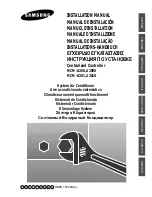
I/O MANUAL Horizontal/Modular/Vertical/Rooftop AHU 2015pg
.
19
COMMERCIAL AIRE PRODUCTS 501 Terminal Road, Fort Worth TX 76106
Tel: 817-624-0820
Liquid Line Sizing
When sizing the liquid line, it is important to minimize the refrigerant charge to reduce installation costs
and improve system reliability. This can be achieved by minimizing the liquid line diameter. However,
reducing the pipe diameter will increase the velocity of the liquid refrigerant which increases the
frictional pressure drop in the liquid line, and causes other undesirable effects such as noise.
Maintaining the pressure in the liquid line is critical to ensuring sufficient saturation temperature,
avoiding flashing upstream of the TXV, and maintaining system efficiency. Pressure losses through the
liquid line due to frictional contact, installed accessories, and vertical risers are inevitable. Maintaining
adequate sub-cooling at the condenser to overcome these losses is the only method to ensure that
liquid refrigerant reaches the TXV.
Liquid refrigerant traveling upwards in a riser loses head pressure. If the evaporator is below the
condenser, and the liquid line does not include risers, the gravitational force will increase the pressure
of the liquid refrigerant. This will allow the refrigerant to withstand greater frictional losses without the
occurrence of flashing prior to the TXV.
A moisture-indicating sight glass may be field installed in the liquid line to indicate the occurrence of
premature flashing or moisture in the line. The sight glass should not be used to determine if the system
is properly charged.
Use temperature and pressure measurements to determine liquid sub-cooling,
not the sight glass.
Liquid Line Routing
Care should be taken with vertical risers. When the system is shut down, gravity will pull liquid down the
vertical column, and back to the condenser when it is below the evaporator. This could potentially result
in compressor flooding. A check valve can be installed in the liquid line where the liquid column rises
above the condenser to prevent this. The liquid line is typically pitched along with the suction line, or
hot gas line, to minimize the complexity of the configuration.
Liquid Line Insulation
When the liquid line is routed through regions where temperature losses are expected, no insulation is
required, as this may provide additional sub-cooling to the refrigerant. When routing the liquid line
through high temperature areas, insulation of the line is appropriate to avoid loss of sub-cooling through
heat gain.
Liquid Line Guidelines
In order to ensure liquid at the TXV, frictional losses must not exceed available sub-cooling. A commonly
used guideline to consider is a system design with pressure losses due to friction through the line not to
exceed a corresponding 1-2°F change in saturation temperature.
If the velocity of refrigerant in the liquid line is too great, it could cause excessive noise or piping
erosion. The recommended maximum velocities for liquid lines are 100 fpm from the condenser to a
receiver tank to discourage fluid backup, and 300 fpm from receiver tank to the evaporator to minimize
valve induced liquid hammer.
Liquid Line Accessories











































